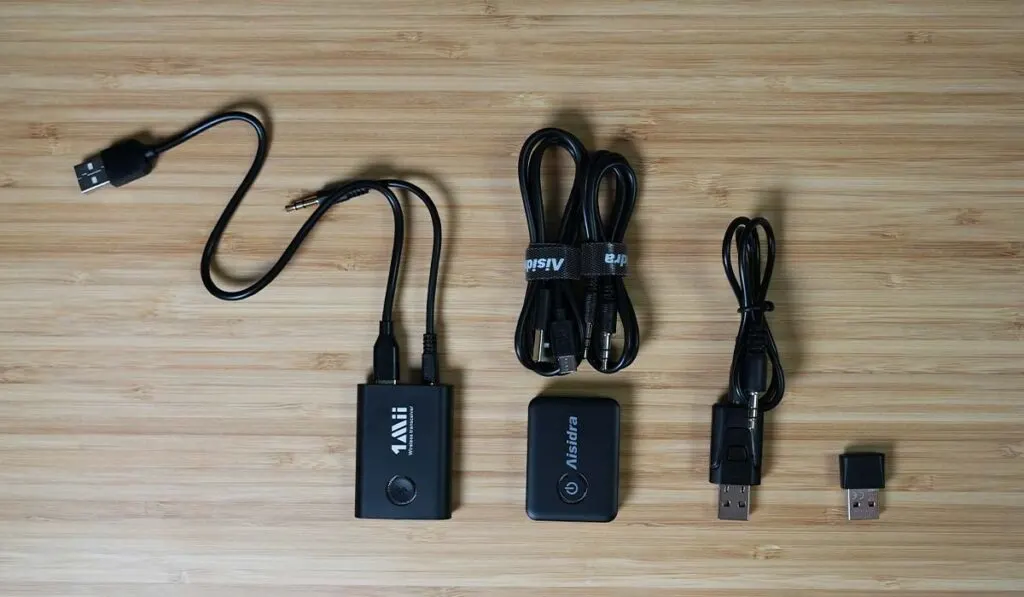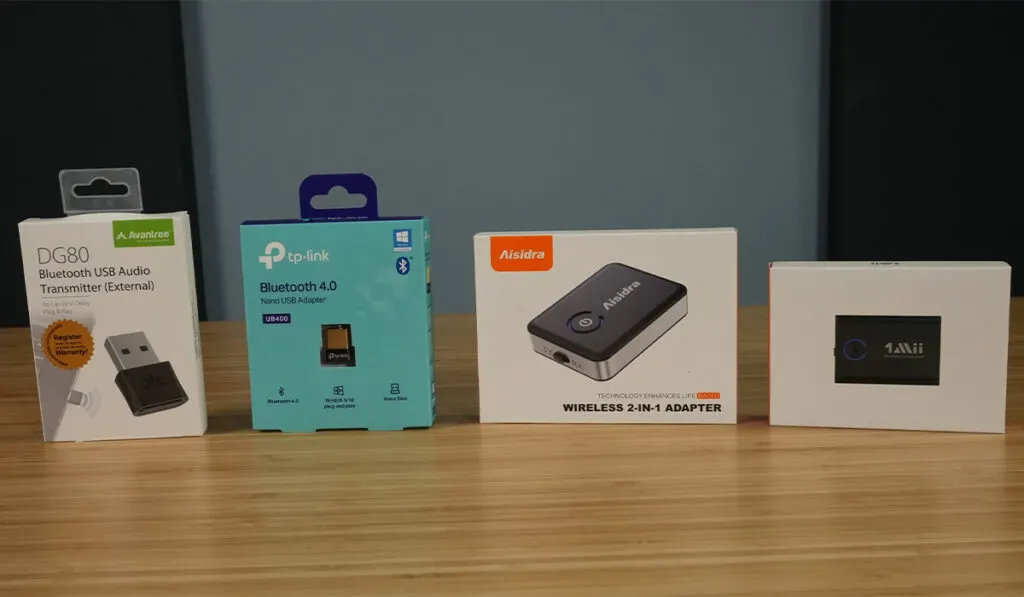Once a common way to stream music wirelessly, Bluetooth has evolved into something that does so much more. We’ve seen it in everything from headphones to keyboards to fitness trackers. Even the devices without a built-in Bluetooth can be turned into Bluetooth-enabled devices with the help of a receiver. But what exactly is a Bluetooth receiver, and what is a transmitter?
A receiver accepts Bluetooth signals and converts them so that they can be played on devices that don’t have Bluetooth capability. A transmitter, on the other hand, takes the analog signal from a device like a TV and converts it before broadcasting it to be received by a Bluetooth-enabled device.
Bluetooth technology uses short-wavelength radio transmissions to communicate between devices. It’s a low-power way to wirelessly connect devices, which means it won’t drain your battery as quickly as other methods like Wi-Fi. But many useful devices like old stereos or TVs lack this technology. That’s where compatibility gadgets like receivers and transmitters come in to help. So, let’s find out a little more about these devices and how they work.
What is a Bluetooth Receiver?

A Bluetooth receiver enables a non-Bluetooth device to connect wirelessly to a Bluetooth-compatible device. It’s usually a small gadget that plugs into an audio jack or a USB port. You switch it on, pair it with a Bluetooth device like your smartphone or tablet, and you’re ready to start streaming audio wirelessly.
So, for example, let’s say you want to listen to music from your phone on your car stereo. If your car doesn’t have Bluetooth, you can use a Bluetooth receiver to connect the two devices wirelessly.
You just need to plug the receiver into the AUX port or the USB hub, depending on your car, and then pair it with your phone.
Once it’s connected, the music will play through your car speakers. Receivers are also used to connect other types of devices wirelessly. For example, you can use it to connect a Bluetooth keyboard to a computer that doesn’t have Bluetooth capability.
Essentially, a Bluetooth receiver or transmitter bridges the gap so you can enjoy the convenience of wireless connection between non-compatible devices. Before further explaining how a Bluetooth receiver works, let’s first explore a few important features.
What Are the Features of a Bluetooth Receiver?
Range: The range of a Bluetooth receiver is the maximum distance it can be from the transmitter (e.g., your phone) and still maintain a connection.
Good Bluetooth receivers have a range of around 10 meters (30 feet). Some models advertise a much longer range, but in general, Bluetooth signals tend to degrade the further they have to travel.
Latency: Low latency is important when you’re using a Bluetooth receiver for gaming or watching movies. It ensures that the audio transmitted wirelessly is in sync with what you see on screen.
A delay of even a few milliseconds can be noticeable and disrupt the experience, so you want to aim for as close to zero latency as possible.
Compatibility: Most Bluetooth receivers will work with any stereo system or speaker that has an aux port. However, devices (like Carplay) with operating systems may need an extra dongle or specific software to be compatible.
Bluetooth version: The latest Bluetooth version is 5.2, but many devices aren’t compatible with it yet. So most Bluetooth receivers are also on an older version, like 3.0, 4.0, and 4.2. Unless you have a specific reason for needing the latest Bluetooth version, this shouldn’t be a make-or-break factor.
What’s the Difference Between a Bluetooth Receiver and a Transmitter?

A Bluetooth transmitter is the opposite of a receiver. It’s used to produce Bluetooth signals from a device that doesn’t have built-in Bluetooth. So the key difference is transmitters send Bluetooth signals, and receivers receive them.
A transmitter encodes digital or analog audio signal data into Bluetooth Low Energy (BLE) packets and channels them into the surrounding.
A Bluetooth receiver, on the other hand, receives and decodes the packets into an audio signal that can be played on a non-Bluetooth device.
This is how Bluetooth-enabled devices communicate with each other. So, for example, you’ll need a Bluetooth transmitter to broadcast music from an old analog TV to a Bluetooth speaker or set of headphones.
Bluetooth receivers and transmitters can be used together to create a wireless connection between two devices when neither of them has Bluetooth.
In this case, the transmitter would be connected to the source device (e.g., TV), and the receiver would be connected to the destination device (e.g., speaker).
How do Bluetooth Receivers Work?
A Bluetooth receiver has two parts: an antenna and a chipset. The antenna picks up Bluetooth signals from a transmitting device in the range, which could be your phone, laptop, or smart TV.
Then the chipset is the brain that decodes the incoming signals and translates the signal into an audio format compatible with the receiving device’s.
These communications are then transferred to the receiving device, where they’re converted back into an audio signal. The chipset also handles other important tasks like pairing devices, maintaining connections, and processing data.
Can You Use a Bluetooth Receiver as a Transmitter?
Usually, no. A Bluetooth receiver is designed for one-way communication only. The chipset inside is made for decoding signals, not encoding them. Similarly, a Bluetooth transmitter won’t be able to receive signals.
However, a few manufacturers have come out with devices that can do both. They have the hardware necessary to transmit and receive signals, so the device switch depending on what’s needed.
Auris Beamit, CUBETEK 2in 1, and ZIIDOO Bluetooth 5.0 are examples of dual-mode transmitters. All these models support aptX audio codec to decrease latency and deliver high-quality sound.
Dual devices tend to be more expensive than a single-purpose Bluetooth transmitter or receiver. But the convenience may be worth the extra money.
How do You Use a Bluetooth Receiver?
Bluetooth receivers are plug-and-play devices; just follow the simple steps given below:
- Plug the receiver into the stereo system or speaker you want to use and set its output to the aux port. Make sure the speaker is in the range of the transmitter and that there are not too many obstacles (like walls) in the way that could degrade the signal.
- Turn on the Bluetooth receiver and put it into pairing mode. This is usually done by pressing a button for a few seconds until you see a flashing light.
- On your phone, open the Bluetooth settings and make sure that Bluetooth is turned on.
- Find the Bluetooth receiver in the list of available devices and select it.
- If prompted, enter a PIN or password, usually 0000 or 1234. Some devices allow setting up a custom code.
- You should see “connected” next to the Bluetooth receiver’s name when the pairing is successful.
- Start playing your audio content and enjoy
- To end the connection, simply turn off the Bluetooth receiver or go into your phone’s Bluetooth settings and disconnect it.
Next time you want to use it, just repeat steps 2-9. Some receivers will automatically reconnect to the last paired device when turned on.
Most receivers remember the paired device and automatically connect when that device is in range, so you won’t have to go through the process every time.
Some receivers can even connect to multiple devices simultaneously and allow you to switch between them with the press of a button.
Best Bluetooth Receivers for Home Stereo
Any good Bluetooth receiver can easily turn your ancient speaker into a Bluetooth-ready device. But some nitty-gritty details differentiate the best from the rest. So here are our top three picks with a detailed explanation of what we love about each one.
Top Pick: Audioengine B1 Bluetooth Music Receiver
One of the most popular Bluetooth receivers on the market and for good reason. The Audioengine B1 has a great range, extended battery life, and a few extras that make it a great value for the money.
What We Love;
- The latest Bluetooth 5.0 with all the bells and whistles is great for those with the latest devices.
- The built-in DAC means you don’t have to worry about compatibility, and gold-plated RCA gives you the flexibility to connect to just about any speaker or stereo system.
- Powerful aptX HD, aptX coding can deliver 24-bit audio quality over Bluetooth; even serious audiophiles will be impressed.
- The extended range of more than 100 feet means you can enjoy your music from anywhere in your home without worrying about the signal dropping.
- The team behind Audioengine is passionate about great sound and excellent customer service. They offer a 3-year product coverage which is one of the best in the business.
First Runner Up: StarTech Bluetooth 5.0 Audio Receiver
StarTech has many impressive receivers, but this BT52A model is our favorite for its versatility and affordable price tag. It’s a great choice for those who want to use their receiver in multiple ways.
What We Love;
- The small size means it’s very portable, and you can discreetly connect it to your stereo system and enjoy music without any messy wires.
- Featuring HiFi grade Wolfson DAC and Bluetooth 5.0, it gives the best possible sound quality on wireless.
- Along with analog RCA input, it has Digital optical Toslink (SPDIF) input which gives you more options for connecting to any NFC devices, so even Bluetooth-enabled devices enjoy a better connection with it.
- You also get an impressive 48KHz, 24-bit sample rate for perfect audio sync.
- This receiver comes with a -80dBm noise floor, which means you get very little interference even when many devices are connected in the same area.
Budget Pick: Nuforce BTR100 Bluetooth Receiver
A perfect choice if you want quality without spending a lot of money. The Nuforce BTR100 is a great entry-level receiver that gives you the basics at an affordable price.
What We Love
- It’s a sleek, small, nicely finished box about the size of a deck of cards. It’s effortless to carry around and can be discreetly connected to any speaker.
- Despite the low price tag, it has advanced audio coding that gives over 250 kbps streaming quality.
- A dynamic DAC with line-level analog output means you can connect it to an amplifier or active speaker.
So, there you have it. These plug-and-play devices can turn any device into a Bluetooth-enabled one.
So, whether you’re looking for the latest and greatest technology or just want a cheap and easy way to add Bluetooth to your home stereo, there’s a receiver here that will fit your needs.
